Related Research Articles

Hydroponics is a type of horticulture and a subset of hydroculture which involves growing plants, usually crops, without soil, by using water-based mineral nutrient solutions in aqueous solvents. Terrestrial or aquatic plants may grow with their roots exposed to the nutritious liquid or in addition, the roots may be physically supported by an inert medium such as perlite, gravel, or other substrates. Despite inert media, roots can cause changes of the rhizosphere pH and root exudates can affect rhizosphere biology and physiological balance of the nutrient solution by secondary metabolites.

A terrarium is usually a sealable glass container containing soil and plants, and can be opened for maintenance to access the plants inside. However, terraria can also be open to the atmosphere rather than being sealed. Terraria are often kept as decorative or ornamental items. Closed terraria create a unique environment for plant growth, as the transparent walls allow for both heat and light to enter the terrarium.
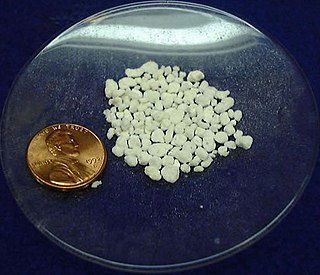
Perlite is an amorphous volcanic glass that has a relatively high water content, typically formed by the hydration of obsidian. It occurs naturally and has the unusual property of greatly expanding when heated sufficiently. It is an industrial mineral, suitable "as ceramic flux to lower the sintering temperature", and a commercial product useful for its low density after processing.
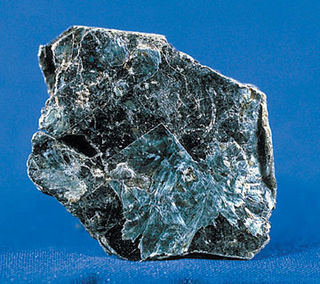
Vermiculite is a hydrous phyllosilicate mineral which undergoes significant expansion when heated. Exfoliation occurs when the mineral is heated sufficiently, and commercial furnaces can routinely produce this effect. Vermiculite forms by the weathering or hydrothermal alteration of biotite or phlogopite. Large commercial vermiculite mines currently exist in the United States, Russia, South Africa, China, and Brazil.
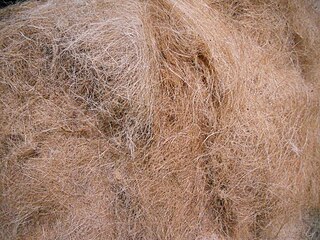
Coir, also called coconut fibre, is a natural fibre extracted from the outer husk of coconut and used in products such as floor mats, doormats, brushes and mattresses and from cotton flax plant was discovered. Coir is the fibrous material found between the hard, internal shell and the outer coat of a coconut. Other uses of brown coir are in upholstery padding, sacking and horticulture. White coir, harvested from unripe coconuts, is used for making finer brushes, string, rope and fishing nets. It has the advantage of not sinking, so can be used in long lengths in deep water without the added weight dragging down boats and buoys.

Sodium silicate is a generic name for chemical compounds with the formula Na
2xSi
yO
2y+x or (Na
2O)
x·(SiO
2)
y, such as sodium metasilicate Na
2SiO
3, sodium orthosilicate Na
4SiO
4, and sodium pyrosilicate Na
6Si
2O
7. The anions are often polymeric. These compounds are generally colorless transparent solids or white powders, and soluble in water in various amounts.

Stucco or render is a construction material made of aggregates, a binder, and water. Stucco is applied wet and hardens to a very dense solid. It is used as a decorative coating for walls and ceilings, exterior walls, and as a sculptural and artistic material in architecture. Stucco can be applied on construction materials such as metal, expanded metal lath, concrete, cinder block, or clay brick and adobe for decorative and structural purposes.
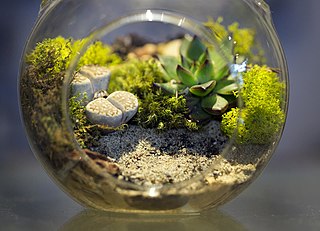
A vivarium is an area, usually enclosed, for keeping and raising animals or plants for observation or research. Often, a portion of the ecosystem for a particular species is simulated on a smaller scale, with controls for environmental conditions.

Puffed grains are grains that have been expanded ("puffed") through processing. They have been made for centuries with the simplest methods like popping popcorn. Modern puffed grains are often created using high temperature, pressure, or extrusion.

Rice hulls are the hard protecting coverings of grains of rice. In addition to protecting rice during the growing season, rice hulls can be put to use as building material, fertilizer, insulation material, or fuel. Rice hulls are part of the chaff of the rice.

Glass recycling is the processing of waste glass into usable products. Glass that is crushed or imploded and ready to be remelted is called cullet. There are two types of cullet: internal and external. Internal cullet is composed of defective products detected and rejected by a quality control process during the industrial process of glass manufacturing, transition phases of product changes and production offcuts. External cullet is waste glass that has been collected or reprocessed with the purpose of recycling. External cullet is classified as waste. The word "cullet", when used in the context of end-of-waste, will always refer to external cullet.
Riceland Foods, Inc. is a farmer-owned agricultural marketing cooperative and the world's largest miller and marketer of rice. The company was founded in 1921 with headquarters in Stuttgart, Arkansas. Riceland owns and operates seven rice mills, including the largest rice mill in the world, located in Jonesboro, Arkansas. More than two-thirds of Riceland's business is delivering, milling, storing, marketing and distributing rice.

Akadama is a naturally occurring, granular clay-like mineral used as soil for bonsai trees and other container-grown plants. It is surface-mined, immediately sifted and bagged, and supplied in various grades; the deeper-mined grade are somewhat harder and more useful in horticulture than the more softer, shallow-mined grades. Akadama may also act as one component of growing medium when combined with other elements such as sand, composted bark, peat, or crushed lava. The color darkens when moist which can help the grower determine when to water a tree.

Construction aggregate, or simply aggregate, is a broad category of coarse- to medium-grained particulate material used in construction, including sand, gravel, crushed stone, slag, recycled concrete and geosynthetic aggregates. Aggregates are the most mined materials in the world. Aggregates are a component of composite materials such as concrete and asphalt; the aggregate serves as reinforcement to add strength to the overall composite material. Due to the relatively high hydraulic conductivity value as compared to most soils, aggregates are widely used in drainage applications such as foundation and French drains, septic drain fields, retaining wall drains, and roadside edge drains. Aggregates are also used as base material under foundations, roads, and railroads. In other words, aggregates are used as a stable foundation or road/rail base with predictable, uniform properties, or as a low-cost extender that binds with more expensive cement or asphalt to form concrete. Although most kinds of aggregate require a form of binding agent, there are types of self-binding aggregate which do not require any form of binding agent.
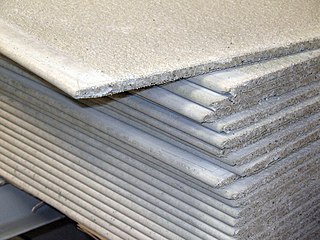
A cement board is a combination of cement and reinforcing fibers formed into sheets, of varying thickness that are typically used as a tile backing board. Cement board can be nailed or screwed to wood or steel studs to create a substrate for vertical tile and attached horizontally to plywood for tile floors, kitchen counters and backsplashes. It can be used on the exterior of buildings as a base for exterior plaster (stucco) systems and sometimes as the finish system itself.

Lightweight expanded clay aggregate (LECA) or expanded clay (exclay) is a lightweight aggregate made by heating clay to around 1,200 °C (2,190 °F) in a rotary kiln. The yielding gases expand the clay by thousands of small bubbles forming during heating producing a honeycomb structure. LECA has an approximately round or potato shape due to circular movement in the kiln and is available in different sizes and densities. LECA is used to make lightweight concrete products and other uses.
Instant rice is a product in which white rice is partially precooked, dehydrated, and repackaged in dried form similar in appearance to regular white rice. That process allows the product to be later cooked as if it were normal rice but with a typical cooking time of 5 minutes, compared to the 20-30 minute preparation time for white rice. This process was invented by Ataullah K. Ozai‐Durrani in 1939 and mass marketed by General Foods starting in 1946 as Minute Rice, a brand which continues until this day.
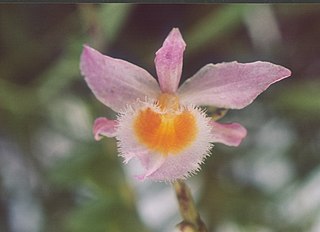
Dendrobium loddigesii is a miniature to small sized, warm to cold growing epiphyte, lithophyte or terrestrial orchid that comes from Laos, Vietnam, and China. It is found in humid, mossy, mixed and coniferous forests at elevations of 1000 to 1500 meters, in areas with dry winter and a wet spring and summer. The plant has tufted, pendant, subterete, striated, several-noded, white-sheathed stems carrying alternate, fleshy, oblong, acute leaves.
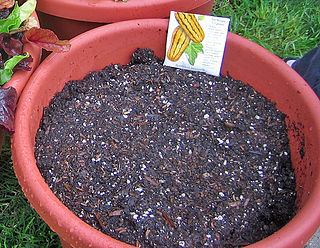
Potting soil, also known as potting mix or potting compost (UK), is a substrate in which to grow plants, herbs and vegetables in a pot or durable container. The first recorded use of the term is from an 1861 issue of the American Agriculturist. Despite its name, little or no soil is usually used in potting soil because it is considered too heavy for growing houseplants. (Some authors and suppliers do, however, make a distinction between "potting soil" and "potting mix" in that the former contains soil and is heavier. Soil-containing mixes are more acceptable in raised beds, as the beds are open to the soil below.
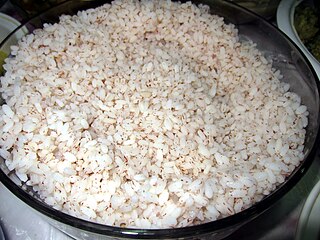
RoseMatta rice is an indigenous variety of rice grown in the Palakkad district of Kerala, India. It is known for its coarseness and health benefits. It is popular in Kerala and coastal Karnataka in India and Sri Lanka where it is used on a regular basis for idlies, appams and plain rice; it is different from brown rice. The robust and earthy flavour of Red Matta makes it suitable to accompany lamb, beef or game meats.
References
- ↑ (2011). "Growstones ideal alternative to perlite, parboiled rice hulls". American Society for Horticultural Science http://esciencenews.com/articles/2011/12/14/growstones.ideal.alternative.perlite.parboiled.rice.hulls
- ↑ Evans, Michael (February 2011). "Physical Properties of and Plant Growth in Peat-based Root Substrates Containing Glass-based Aggregate, Perlite, and Parboiled Fresh Rice Hulls". HortTechnology. 21 (1): 30–34. doi: 10.21273/HORTTECH.21.1.30 .